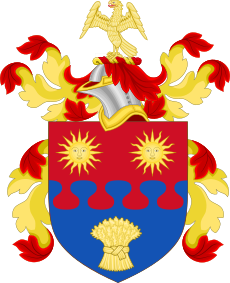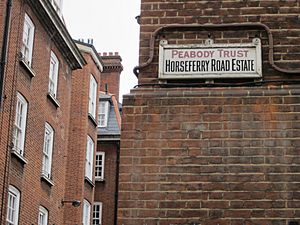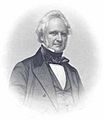George Peabody facts for kids
Quick facts for kids
George Peabody
|
|
|---|---|
 |
|
| Born | February 18, 1795 |
| Died | November 4, 1869 (aged 74) No. 80 Eaton Square, London, England
|
| Resting place |
|
| Occupation | |
| Parent(s) | Thomas Peabody and Judith Dodge |
| Signature | |
George Peabody (PEE-bə-dee; February 18, 1795 – November 4, 1869) was an American financier and philanthropist. He is often called the "father of modern philanthropy." This means he was one of the first to give away large amounts of money to help others.
George Peabody was born into a poor family in Massachusetts. He started his career in business, first selling goods and then becoming a banker. In 1837, he moved to London, England, which was a major financial center. There, he became a very important American banker. He helped the young United States build its financial reputation around the world.
Peabody didn't have any sons to take over his business. So, in 1854, he partnered with Junius Spencer Morgan. After Peabody retired in 1864, their company grew into the famous financial firm J.P. Morgan & Co..
In his later years, Peabody became famous for his generosity. He started the Peabody Trust in Britain, which built affordable homes for poor families. In the United States, he founded the Peabody Institute and the George Peabody Library in Baltimore. He also supported many other good causes. For his kindness, he received many honors, including the Congressional Gold Medal.
Contents
George Peabody's Early Life and Career
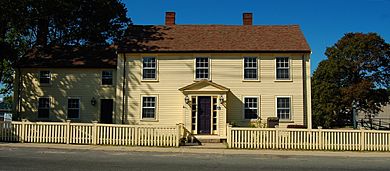
George Peabody was born in 1795 in a place called South Danvers, Massachusetts. This town is now named Peabody in his honor. His family had Puritan ancestors. George was one of seven children in a poor family. He didn't get to go to school for many years.
When he was a teenager, his father passed away. George then worked in his brother's shop to help his mother and six siblings. He later said he would "never forget the great difficulties of my early years." These experiences made him value saving money and helping others.
In 1816, George moved to Baltimore, Maryland. He lived and worked there for the next 20 years. He became a successful businessman and financier.
Moving to London and International Banking
In the early 1800s, major cities like London, Paris, and Frankfurt were the centers of world finance. Countries like the United States needed help from European banks to get money for big projects. These projects included building roads, railroads, and canals.
Peabody first visited England in 1827. He wanted to sell American state bonds to raise money for these projects. Over the next ten years, he traveled across the Atlantic Ocean four more times. He opened an office in Liverpool, England. Later, he started his own banking firm, "George Peabody & Company," in London. In 1837, he moved to London for good and lived there for the rest of his life.
In the 1840s, the state of Maryland stopped paying its debts to European investors. Peabody had sold many of Maryland's bonds. This made him unpopular in London. He worked hard to convince Maryland to start paying its debts again. He even bought more of Maryland's bonds when they were cheap. When Maryland finally resumed payments, Peabody made a good profit. This helped improve America's financial standing in Europe.
Personal Life and Social Gatherings
Peabody never married. He often hosted parties and dinners for American businessmen visiting London. He was known for his Anglo-American dinners, especially those celebrating the Fourth of July.
In 1851, the U.S. Congress didn't want to pay for the American section at the Great Exhibition in London. George Peabody stepped in and gave £3,000 (about $550,000 today) to improve the exhibit. This helped protect the reputation of the United States. Around this time, Peabody began to suffer from rheumatoid arthritis and gout.
In 1867, when he was 72, some people suggested Peabody could become the U.S. Secretary of the Treasury or even president. Peabody said these were "kind and complimentary" ideas. But he felt he was too old for such important jobs.
George Peabody's Business Success
During the War of 1812, Peabody met Elisha Riggs. In 1814, Riggs helped Peabody start a company called Riggs, Peabody & Co. They imported goods from Britain. Later, Peabody became the main partner, and the company was renamed Peabody, Riggs & Co.
Peabody's business in Britain grew. He opened an office in Liverpool. In 1837, he moved to London and started his own banking business. In 1851, he officially founded "George Peabody and Company." This bank helped finance American railroads and other large companies. It became the leading American bank in London.
Peabody took Junius Spencer Morgan as a partner in 1854. Their new company was called Peabody, Morgan & Co.. They worked together until Peabody retired in 1864. Morgan took over the business from 1859.
In 1857, there was a financial crisis. Peabody's bank needed a large loan from the Bank of England. Even though some rivals tried to make his bank fail, it survived and kept its good reputation.
After this crisis, Peabody began to step back from business. In 1864, he fully retired. He took with him a large amount of money, over $10 million (about £2 million). Peabody, Morgan & Co. then became J.S. Morgan & Co.. Today, major banks like JPMorgan Chase and Morgan Stanley can trace their history back to George Peabody's bank.
George Peabody's Philanthropy
Even though he was careful with money for himself, George Peabody gave very generously to public causes. He is known as the "father of modern philanthropy." He set an example for other wealthy people like Andrew Carnegie and John D. Rockefeller.
In the United States, Peabody mostly supported education. In 1867–68, he created the Peabody Education Fund. He gave $3.5 million to help educate poor children in the Southern states after the Civil War. His biggest gift was to Baltimore, Maryland, where he first found success.
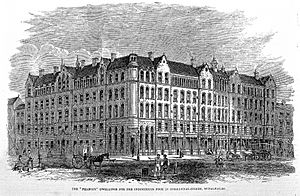
In Britain, Peabody focused on providing homes for the poor. In April 1862, he started the Peabody Donation Fund, which is now called the Peabody Trust. This trust still provides good quality housing for working-class people in London. The first homes opened in London in 1864.
George Peabody gave away more than $8 million during his lifetime. This would be like giving away $158 million today!
Here are some of the institutions he supported:
- 1852: The Peabody Institute Library, Peabody, Massachusetts: $217,000
- 1857: The Peabody Institute of the Johns Hopkins University, Baltimore: $1,400,000. He wanted to offer learning, music, and art to the people of Baltimore.
- 1862: The Peabody Donation Fund, London: $2,500,000
- 1866: The Peabody Museum of Archaeology and Ethnology, Harvard University: $150,000
- 1866: The Peabody Museum of Natural History, Yale University: $150,000
- 1867: The Peabody Academy of Science, Salem, Massachusetts: $140,000
- 1867: Peabody Education Fund: $2,000,000
- 1875: George Peabody College for Teachers, now part of Vanderbilt University, Nashville, Tennessee.
Death and Legacy

George Peabody passed away in London on November 4, 1869, at age 74. He was given a special funeral and a temporary burial place in Westminster Abbey. This was a great honor.
His will stated that he wanted to be buried in his hometown, South Danvers, Massachusetts. The British Prime Minister, William Ewart Gladstone, arranged for Peabody's body to be returned to America on HMS Monarch. This was the newest and largest ship in the Royal Navy.
When his body arrived in Portland, Maine, it was met by U.S. Admiral David Farragut. George Peabody was finally laid to rest in Harmony Grove Cemetery in Salem, Massachusetts, on February 8, 1870. News of his death and funerals traveled quickly around the world thanks to the new trans-Atlantic telegraph cable. Thousands of people attended or watched the ceremonies.
Impact on American Giving
Peabody's way of giving money set a new example for wealthy Americans. He believed that rich people had a duty to give back to their communities. He thought it was best to create lasting institutions like libraries, schools, and museums. These would help educate and enrich young people for many years. He didn't just give cash directly to the poor.
His Peabody Education Fund had a big impact on improving public schools in the Southern states. It was one of the first major charities to give money to both Black and white children, even though schools were still separated by race at the time. Peabody also helped create the idea of professional foundations run by experts. These foundations would guide how large sums of money were given away wisely.
Recognition and Commemoration
Peabody's generosity earned him many admirers. Important people like British Prime Minister William Ewart Gladstone and author Victor Hugo praised him. Queen Victoria even offered to make him a "baronet," a special British honor, but he politely refused.
In 1854, an Arctic explorer named a waterway "Peabody Bay" after him. This was because Peabody had helped fund his expedition.
On July 10, 1862, he was given the "Freedom of the City of London." He was the first of only two Americans to receive this award. On March 16, 1867, he received the United States Congressional Gold Medal. He also received honorary degrees from Harvard University and Oxford University.
His birthplace, South Danvers, Massachusetts, changed its name to Peabody in 1868 to honor him. The Peabody Hotel in Memphis, Tennessee, was also named after him in 1869. Many schools in the United States are named after George Peabody.

A statue of George Peabody stands next to the Royal Exchange in London. It was unveiled in July 1869. A copy of this statue was put up in Baltimore, Maryland, in 1890, next to the Peabody Institute.
In 1900, Peabody was one of the first people chosen for the Hall of Fame for Great Americans in New York. His childhood home in Peabody, Massachusetts, is now the George Peabody House Museum. It teaches visitors about his life. There is also a special marker on the house where he died in London.
On March 16, 2018, Google honored George Peabody with a Google Doodle. This was on the 151st anniversary of him receiving the Congressional Gold Medal.
Images for kids
See also
 In Spanish: George Peabody para niños
In Spanish: George Peabody para niños
- Philanthropy in the United States


